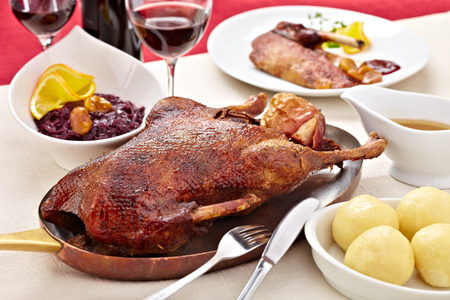

Kill E-Coli in your Christmas Meat: Safe Cooking Temperatures for Lamb, Roast Beef, Duck and Goose
With large meals centered on whole cuts of meat so popular for Christmas holiday meals, the cook should be aware of the dangers of e-coli and food poisoning from under-cooked or mishandled meat. Following safe cooking temperatures and meat handling tips are the best ways to prevent a food poisoning incident in your home.
Every year, millions of Americans are affected by food poisoning. Of these cases, 39 million are diagnosed by a doctor, between 100,000 and 300,000 people are hospitalized for food poisoning and three to five thousand people die. Meat and poultry are the most common culprits of e-coli poisoning.
If you or a loved one was the victim of a serious food poisoning injury, you may benefit from the advice of a personal injury lawyer.
Safe cooking temperatures for lamb, roast beef, duck and goose
When cooking whole duck or goose, the USDA recommends cooking to a minimum internal temperature of 165 °F as measured with a food thermometer. The food thermometer should be placed in the innermost part of the thigh and wing and the thickest part of the breast.
In May of 2011, the USDA released a recommendation on safe cooking temperatures for whole cuts of meat including lamb, veal and roast beef. While the recommendation for the internal cooking temperature remained the same at 145 °F as measured with a food thermometer placed in the thickest part of the meat, additional instructions were added to allow the meat to rest for three minutes before carving or consuming.
Why is rest time important for food safety?
A “rest time” for cooking is the amount of time that the meat or other food item remains at the final temperature after it has been removed from the heat source. During those three minutes the temperature of the meat remains constant or continues to rise, which destroys pathogens. For example, The USDA’s Food Safety and Inspection Service (FSIS) previously recommended that whole cuts of pork be cooked to an internal temperature of 160 °F but upon further study determined that it is just as safe to cook cuts of pork to 145 °F with a three minute rest time as it is to cook them to 160 °F with no rest time.
Common food poisoning symptoms
According to connectforwater.org, the most common signs and symptoms of food poisoning are fever, abdominal pain/cramps, nausea, bloating, vomiting, and diarrhea. In very bad cases, food poisoning can cause bloody diarrhea, dehydration, or liver and kidney problems. Among vulnerable people, food poisoning can be life threatening.
When a group of people endures common symptoms after eating or drinking similar foods, food poisoning could be the culprit.
When should I contact a doctor?
Most cases of food poisoning involve mild to moderate symptoms that resolve themselves within 24-48 hours without any medical treatment necessary. If, however, you are experiencing any of the following symptoms you should seek advice from a medical professional:
- Signs of dehydration which include decreased or no urination, dry mouth, increased thirst, dizziness, and weakness.
- Blood in the stool.
- Fever, vomiting or diarrhea lasting longer than 72 hours.
If you or a loved one is dealing with an accident or injury through no fault of your own, you have enough on your plate. Let an experienced accident attorney fight for the full compensation that you deserve. It is not uncommon to receive a settlement from the insurance company that is five to ten times bigger with the help of a lawyer. Call the caring accident attorneys at Tario & Associates, P.S. in Bellingham, WA today for a FREE consultation! We have been representing residents of Whatcom County, Skagit County, Island County and Snohomish County since 1979. You will pay nothing up front and no attorney fees at all unless we recover damages for you!




